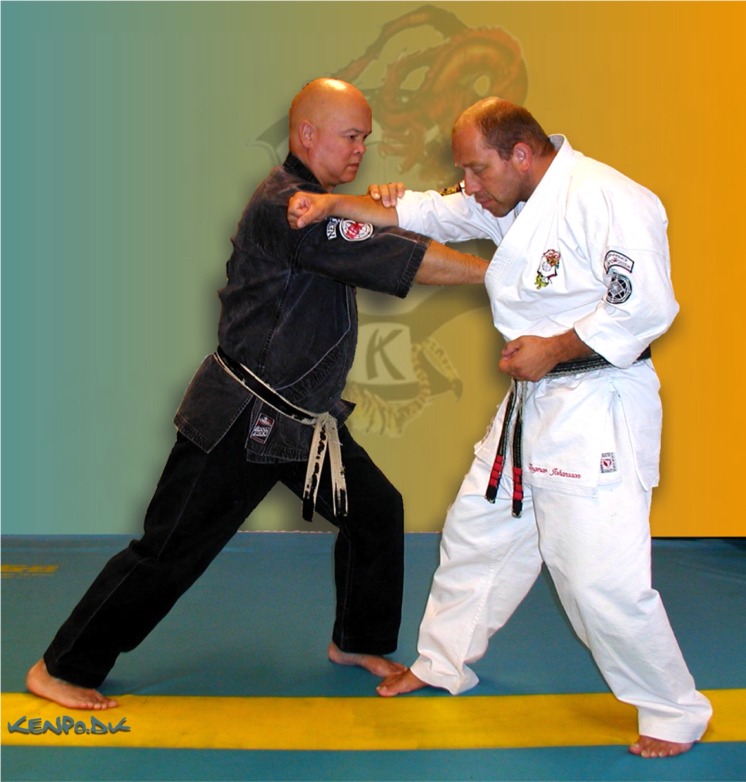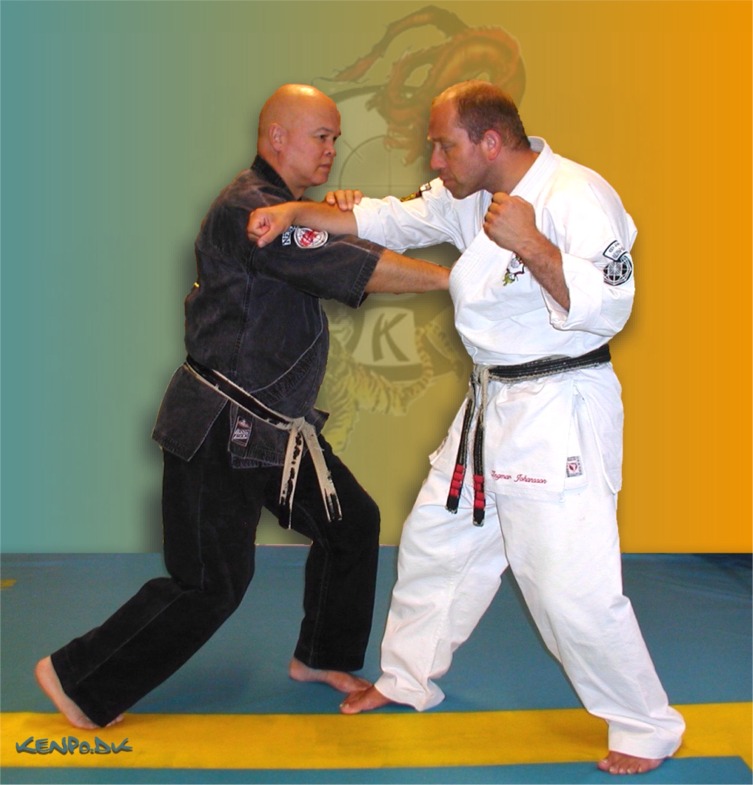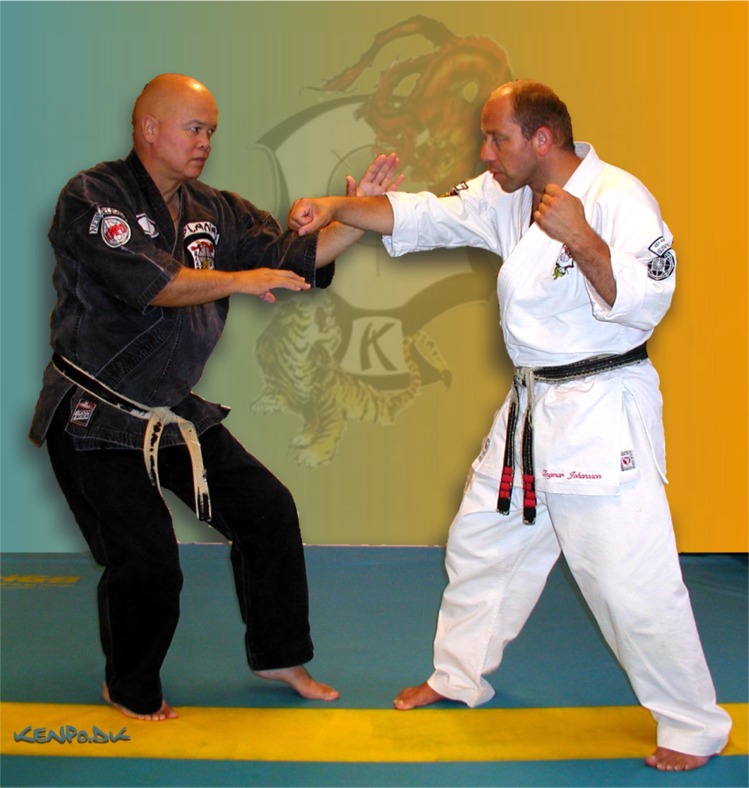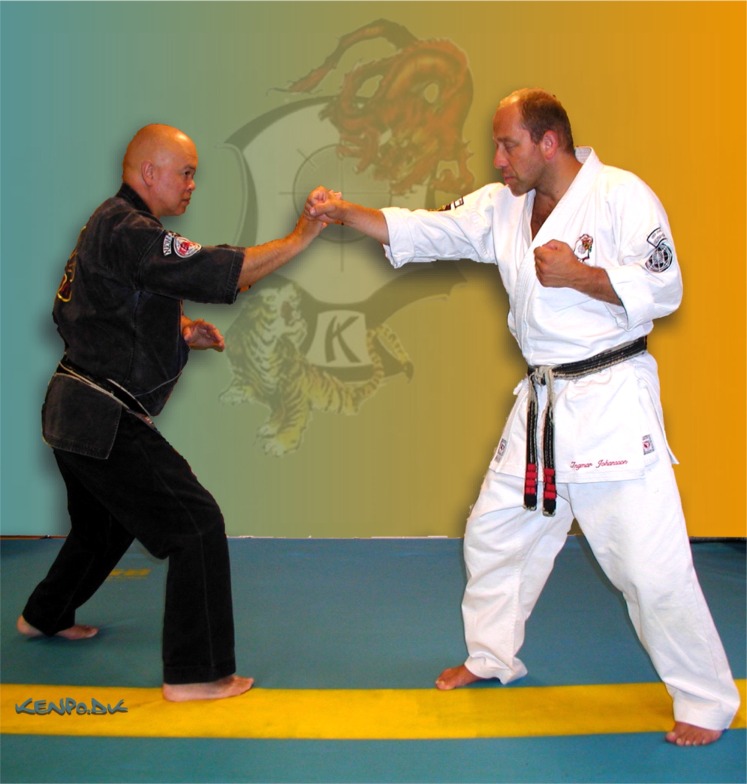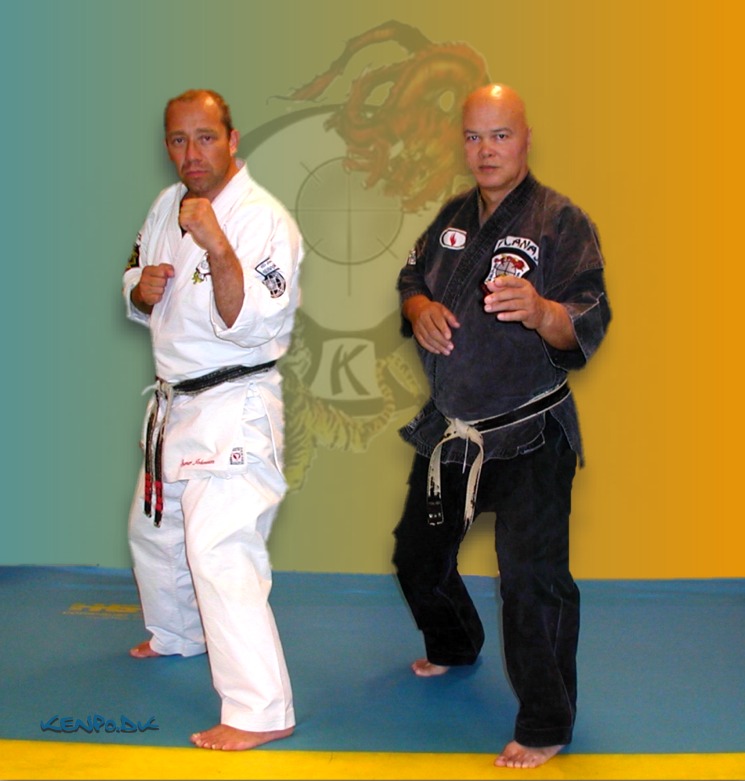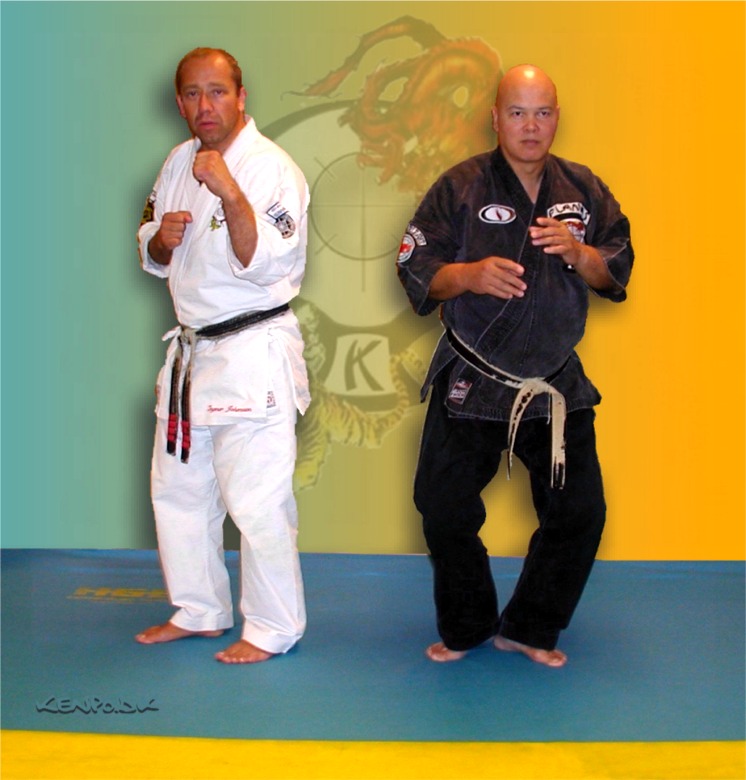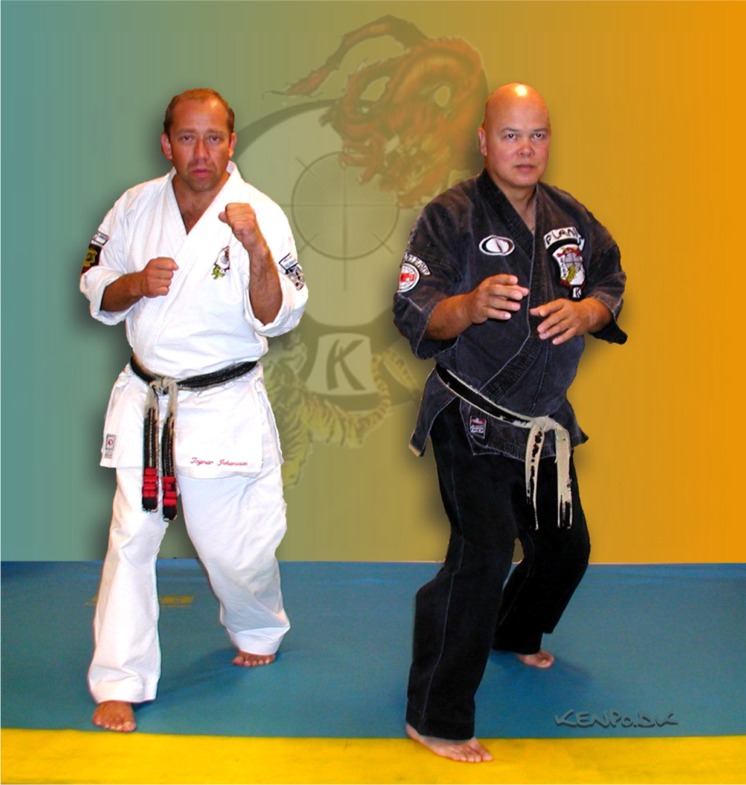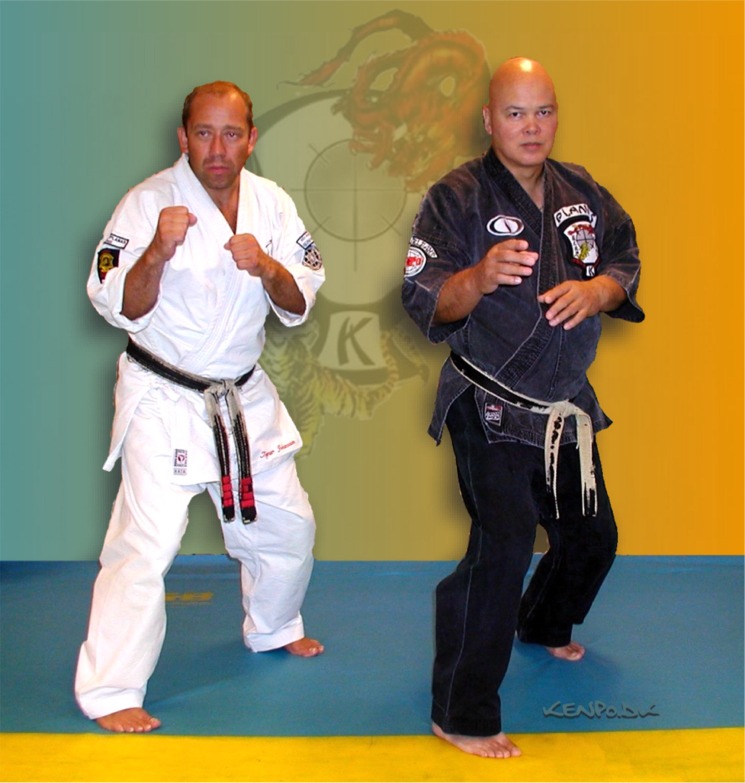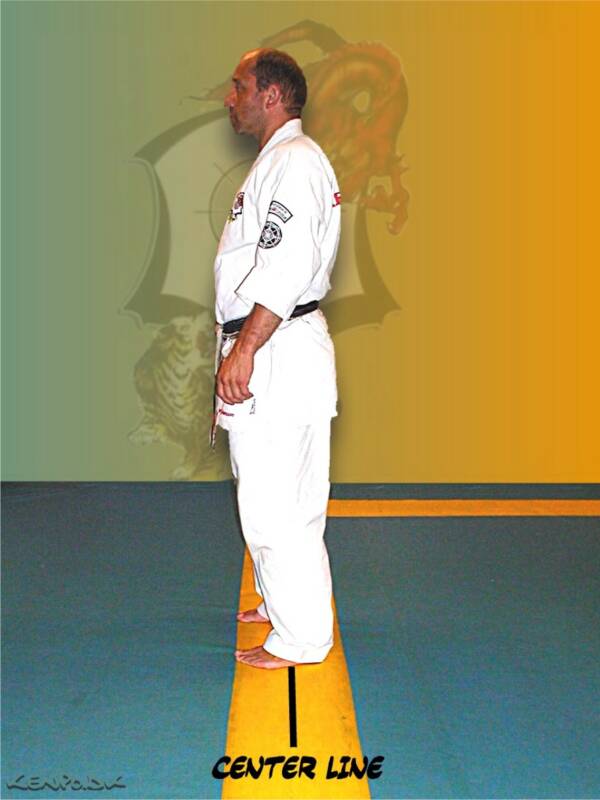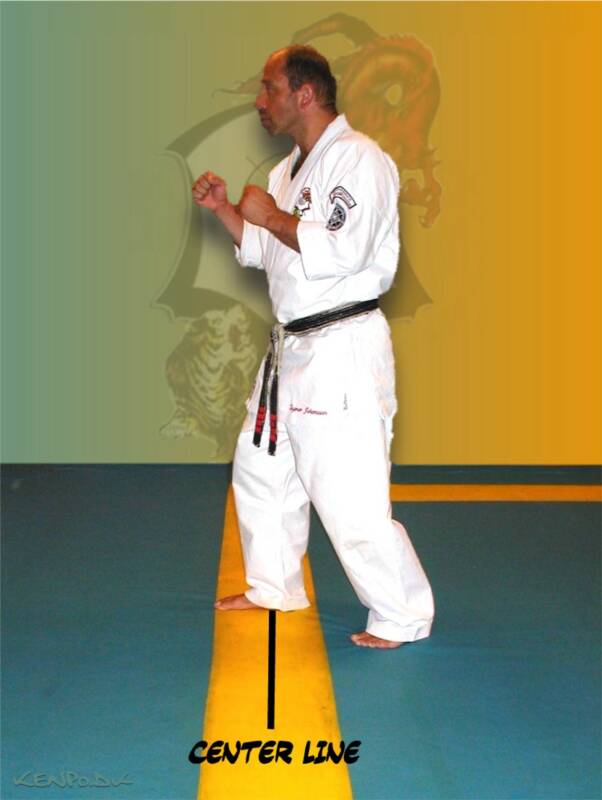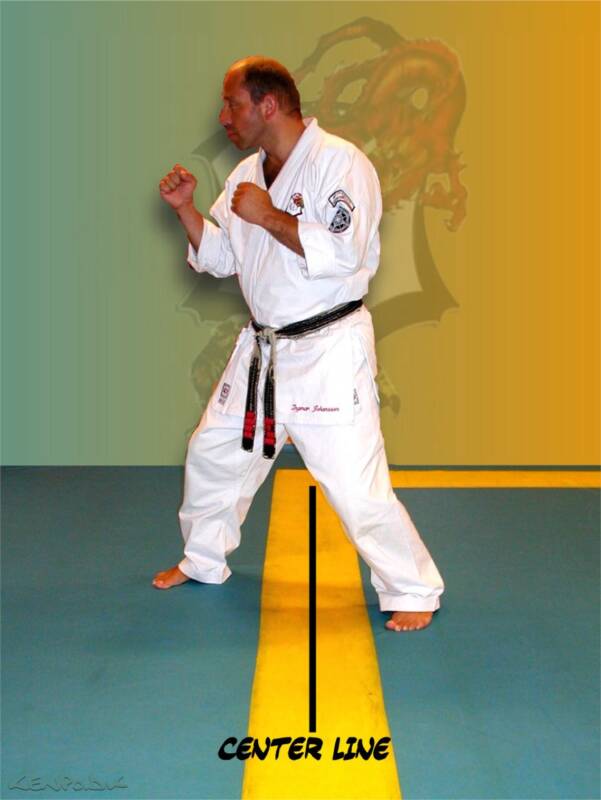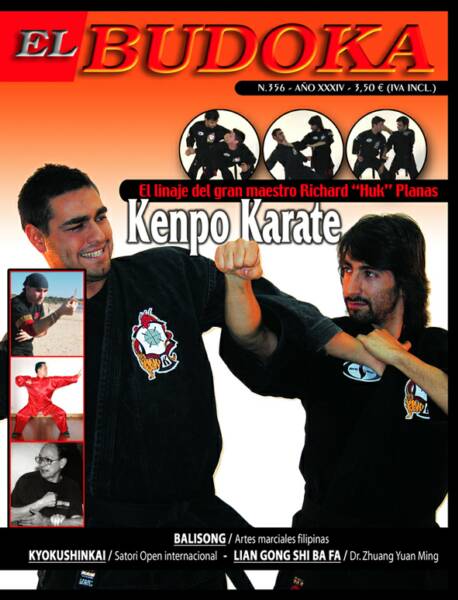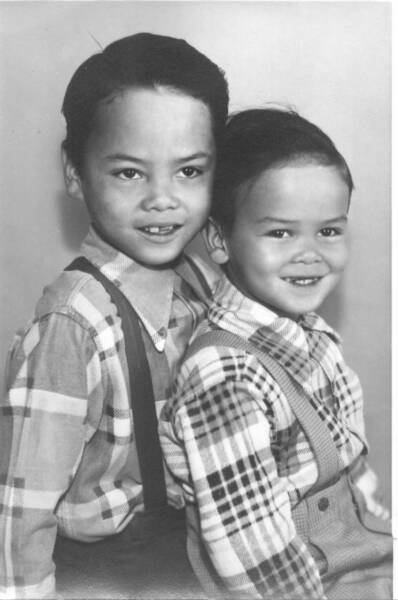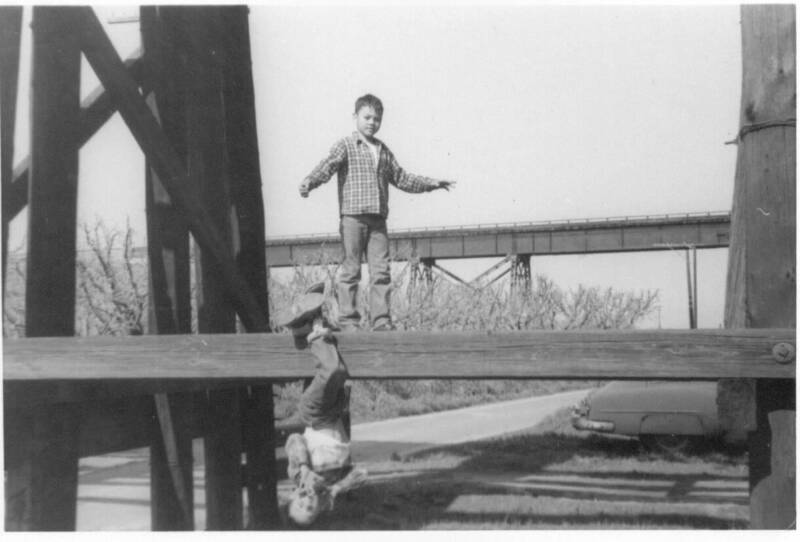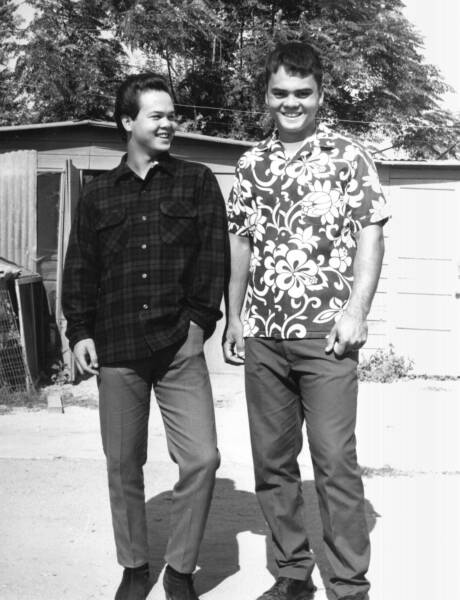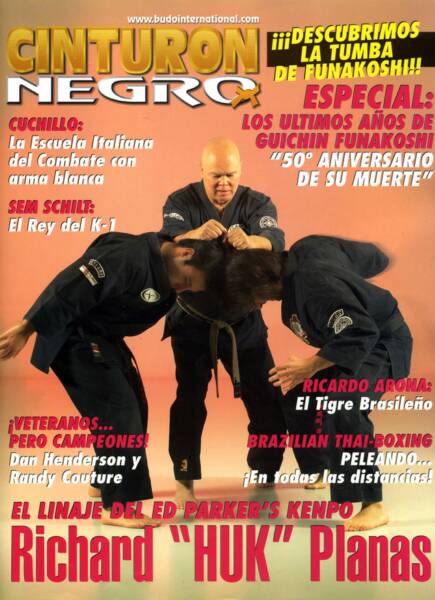Articles
Proper footwork is the key in any art Article By: Ingmar Johansson - Photos And Artwork By: Johnny Hansen
To become really good in any art you have to know and show “Economy of Motion” and in the category of footwork means removing from your footwork all extra or unnecessary moves. When I used to train boxing they used to say if you want to become the best boxer in the world the key is footwork. In the art we have many different ways to move from one point to another. Most of them are related to depth of travelling. There are many different martial arts and many vary from each other in there footwork. This article could analyze all the maneuvers found or used in Kenpo. But I feel that they are very well explained in Mr Parker’s books. Therefore I would like to discuss “Economy of Motion” involved in the footwork and the common errors done by many and the reasons for them in our art.
Basics
Mr Planas says as a teacher, or when teaching, all you correct in a student is improper or bad basics. A problem he sees in many students is poor or weak basics. Remember all we do is basics which are all any system does. In Kenpo terminology basics are any single move like a stance, kick, block, punch etc. We combine these basics to make up our techniques. So it is easy to understand or see that when you make corrections in a student’s motion or techniques it is just correcting basics. Which brings to mind the saying that weak basics equal weak techniques - strong basics equals strong techniques. One has to understand the importance of proper footwork which brings out the maximum effect of the three power principles we use in Kenpo - meaning torque, back-up mass and marriage of gravity as well as proper timing.
Common mistakes
A great way to study the footwork is in the forms. Here the student is under no pressure from an opponent so here we can examine his movements. Students sometimes have a tendency to move the foot more then one time to obtain the desired position. If the students are not taught the basics correctly from the beginning they will usually have the extra steps, move, or moves without realizing it. This equals adding time to your motion or moves. To make corrections in basic footwork long after a student has been doing the art is much harder then teaching him correctly from the beginning. As it has become habit which takes much more thought and work on the student’s part. Breaking the heel or lifting the heel of the rear foot moving in reverse from a forward bow is another very common basics problem. When this is done you are actually delaying your reverse motion on beat. By staying in place or moving forward slightly before you retreat or move back. The proper way to do this should be thought in the early stage of the students training which is found in the “Long Form One”. Floating is also a common beginner basics problem it adds distance and time and also robs power in many techniques like when floating or going up by straitening your supporting leg when delivering a kick on a downward angle like in the last kick in the technique “Dance of Death” if you have learned the complete technique.
Switching
Everything in Kenpo basics is defined around the left and right or front or back. There are two different ways of thinking when defining switching, which by definition means changing sides facing the opponent without losing or gaining distance. You can talk or think about which foot you move or in which direction you move to keep it as simple as possible which is the way most things are explained or laid out in Kenpo. For example in every stance you have a front foot and a back foot. A right neutral bow is called right because the front foot is the right meaning the closest foot to the opponent.
Therefore when you say front to back the simple way to think is move your front foot to the back foot and then move your back foot to the front. To make it longer in explanation you can think of the direction you move. Now when you say back to front means taking your front foot to the back and then move your back foot to the front. No matter which way you do it there should not be more then two moves. And this leads us to another common problem when not using the economy of motion principle. Students often do slight or little adjustment steps to set the neutral base or stance, which really means you are actually doing three moves and not two by adding another “and then”. Switching and shuffles utilize the same timing principle of reverse or opposite and then eliminate the “and then”. To eliminate the “and then” and make the move as fast as possible brings in the hop or jump switch. Meaning that as you move the front foot to the rear the rear foot is moving to the front at the same time. And therefore there is no “and then”.
Shuffling
Shuffling is gauging distance and is not considered part of a technique as it goes where it’s needed to make the technique work. When shuffling you can step and then drag or you can drag and then step, in either case we have the “and then”. The “Push-Drag” eliminates the “and then” which means both feet’s should move together or at the same time. Making it one move where as the “Step-Drag” and “Drag-Step” are two moves. Many people just do a fast “Step-Drag” and think they are doing a “Push-Drag”. No matter how fast this is done it is still two moves. Which still has the “and then”.
Splitting
Splitting is another common error. Once again remember there is a time and place for everything as you can split your stance is certain techniques but its rarely used. Therefore when we say rule we mean 99% or most of the time. The problem with splitting is that you don’t gain or lose any distance which would change the opponents focus point. In which he gauged his footwork for in the first place. That means you have done moves that actually kept you in the same place or focus point of your opponent. Students do this and it is a common mistake. As you can see in the photos I move back with the left foot from my center line and then I move the right leg forward from the center line and as you can see my body is still over the center line or starting point. You could also split by moving the right foot forward first and then step back with the left foot. A third variation would be hopping with both feet at the same time. These timing relationships are exactly the same as the “Switches” used in Kenpo. Either way you don’t gain or lose ground. Learn where and when it’s ok to do splitting and the reasoning why.
Solutions
One of many ways to fix these errors is to train one basic isolated or only a few basic moves at a time in slow motion. You should try to find the feeling of proper body mechanics and feel that the moves is comfortable and makes sense. As instructor it is our job to teach and make students realize the importance of strong basics and it’s our job to make him train or drill it frequently. As we know students don’t like to do basics all the time Mr Planas use the analogy of the reason a boxer hires a trainer. The trainer makes the boxer do his basics over and over again because he will usually not do this on his own.
The art is built like a pyramid upside down. Meaning that we don’t eliminate things we have learned but add to them. Where the top of the pyramid is the foundation meaning we put down one block and then stack more blocks on top etc. On this base we use the rest of our knowledge as building blocks. To build a normal pyramid you have to eliminate building blocks to get to a single block on the top. In Kenpo we never eliminate or discard things we learn, but keep them and add to them. Use at least 30% of your training time to go through and practice your basics. There are things to remember like ”You can lead a horse to the water but you can’t make him drink” another Chinese saying is ”A mistake uncorrected is twice made”. Meaning the horse has to want the water. And one has to want to fix these mistakes or he will keep making them.
For this article in Spanish, please click here.
To contact or provide feedback on the article, please e-mail Mr. Ingmar Johansson at- ingmar@kenpo.se.
For more articles, please click here.
Spanish representatives promote the Parker/ Planas Lineage Article By: Josh Ryer
Mr. Carlos and Sergio Jódar of the United Kenpo Karate Studios headquartered in Madrid, Spain were recently featured on the cover of Spain's best national martial arts magazine, El Budoka.
In the article they explained some of the fundamental concepts and principles of Kenpo Karate and how the system is structured. They also speak of their goal to promote the Parker/ Planas Lineage in Spain.
From all of us in the lineage, we congratulate the Spanish representatives on their recent accomplishment!
For more information about Mr. Carlos and Sergio Jódar and the United Kenpo Karate Studios, please visit their website at- www.kenpoparker.net.
The Planas Paradox Article By: David Calhoun - Photos Courtesy Of: Ed and Suzi Planas
Paradox: A seemingly contradictory statement that may nonetheless be true. (Webster’s Dictionary)
Example: Training concurrently with Richard “Huk” Planas, the famed Kenpo expert, and Ed Planas, Richard’s older brother and Kabaroan Eskrima expert, is a perfect blend.
Richard “Huk” Planas is one of the worlds best known, most knowledgeable, most sought after Kenpoists. Ed Planas, Richard’s older brother, is a master in his own right in Kabaroan Eskrima, and yet is known to only a handful of martial artists. The journey these two brothers have taken is so divergent it is astonishing, and their personalities are a study in stark contrast. Recently, Huk Planas has been exposing kenpoists across the United States to his brother’s expertise, challenging and enhancing their understanding of the principles essential to the mastery of Kenpo. In the following article, we will look at how both brothers took almost parallel journeys on tracks seemingly headed in opposite directions, only to have those “parallel” tracks “intersect” for the betterment of the martial arts community.
Ed Planas is a gregarious, outspoken person, quick with a smile, a hearty hug and a healthy handshake. Richard Planas prefers a quick “Kenpo handshake”, with a hard slap on the back to greet his friends. He smiles most often after hearing a good joke. Once he has said good-bye, he turns and walks away without looking back, on to his next journey. Ed will walk
you to your car and talk to you through the window as you prepare to leave, enjoying conversation with a friend as long as possible. Richard’s conversation is marked by short but direct answers. He will tell you exactly what he thinks about just about anything, even if the answer might damage someone’s ego. The kenpoist who asks his opinion about his/her karate should prepare for an honest assessment, from possibly the most analytical mind in the art. Ed is ever encouraging, and tends to turn one’s mistakes into opportunities for an analysis of other possibilities.
You can rarely get ahold of Richard except by e-mail, as he travels nearly every weekend of the year, teaching Kenpo seminars. Richard has never been married, and has lived an itinerant lifestyle. From his early days at Steve LaBounty’s karate school in Fresno, CA, to El Paso, Texas with Tom Kelly, to Pasadena, CA to train under Mr. Edmund K. Parker Sr., founder of American Kenpo. He moved to Alaska for a time and taught at fellow kenpoist Gil Hibben’s school. He also indulged in other passions while in Alaska, such as hunting, fishing, and making knives with Hibben. His many students from the mainland eventually hounded him enough to convince him to return to California, where he continued to promote the art. He eventually moved to Louisiana and now travels the world almost weekly teaching Kenpo.
Ed Planas and Richard Planas posed at the age six and four.
Ed Planas was born to Humabad L. and Bennie Lee Planas in October 1944 in Louisiana. At a young age he and his family moved to Dinuba, CA, a small agricultural community about 30 miles outside Fresno, CA. He now lives in Fresno. Richard Planas was born in September 1946 in Reedley, CA, about 20 minutes outside Fresno. Richard lived his younger years in Dinuba with his family. He now lives in Louisiana. Ed and Richard’s father, Humabad, was of Filipino descent.
The brother’s parents divorced during their grammar school years, and the boys were raised primarily by their grandmother Alpha on her small ranch in Dinuba. The boys enjoyed imitating the fight sequences they saw on television, especially those in the old westerns, for which they both still have a fondness.
Archery and bullwhips were used in some of those old TV shows, and Richard developed a passion for both. He is now an expert archer, and a bullwhip aficionado, sharing his knowledge with folks all over the world. His is also an extremely accomplished guitar player. Richard’s father, who lived nearby, introduced Richard to Kali, and the Filipino martial arts, as he sometimes took Richard to the Filipino labor camps in the area, where “uncles” taught him about the Filipino arts.
Ed remembers seeing martial arts used in movies such as The Manchurian Candidate, sparking an interest in him that remained until the opportunity to begin his martial journey arrived years later.
In October of 1966, at the age of 22, Ed Planas was drafted into the U.S. Army. In 1967, while stationed in Korea, he joined a “Karate Club” taught by a man named Mr. Moon, a Korean Rock Army Instructor. He trained for approximately one year, achieving the rank of Red Belt in Tae Kwon Do. The training was brutal, as one might expect. It was conducted outside on a concrete slab, and Mr. Moon had no time for those not willing to go the distance. The club met several times a week, and Ed attended regularly. Ed was honorably discharged from the Army in September of 1968, effectively ending his study of Tae Kwon Do.
Shortly after graduating from high school, a friend of Richard’s invited him to attend a class at his Kenpo karate school. That school was run by legendary kenpoists Steve LaBounty and Tom Kelly. He was immediately taken with the art, and began attending classes regularly. Richard’s formal training in Kenpo began while his brother Ed was away in the service. Neither Ed nor Richard was aware the other was training until after Ed returned home in 1968.
Not long after Richard began training in Kenpo, he followed Tom Kelly to El Paso, Texas to assist Mr. Kelly in teaching there. It was in these early days with Mr. Kelly when Kelly gave Richard the nickname “Huk”, referring to the look of many Filipino fighters. They both soon moved to Pasadena, CA to begin training directly under Founder Edmund K. Parker Sr. Mr. Kelly introduced Richard to Mr. Parker, using Richard’s nickname. Mr. Parker quickly adopted the nickname as well, and Richard is still referred by those close to him as “Huk”. A lifelong friendship soon developed between Mr. Parker and Richard Planas. No one knew at the time that Mr. Parker’s lifetime would not be as long as we all would have liked.
Ed Planas is usually home, or soon will be. He and his wife Suzi are avid churchgoers, attending services several times a week. Ed recently retired from the California Highway Patrol. He enjoys his retirement but continues to benefit the law enforcement community by teaching use of force options and other law enforcement subjects to future law enforcement officers at the Fresno City College Police Academy.
Both men are deceptively strong. When either grabs ahold of you, you know you’ve been grabbed. One is on the tall side and has a full head of hair, one is on the short side and…, well, doesn’t.
Both men work with others without posturing or visible ego. Ed Planas is reluctant to divulge his rank. He goes simply
by the title Guro. This is not uncommon amongst those who study the Filipino arts. Ed’s instructor, Ramiro Estallilla Jr., Grandmaster of Kabaroan Eskrima, refers to Ed Planas as a Master Level Instructor. Richard Planas has been outspoken for years about how he dislikes the idea of rank, stressing that the study of martial arts should be a quest to make oneself as proficient as possible, not a contest with one’s neighbor. He often asks his students the question, “Who would continue in the arts if not for the constant rewards of another belt color?” Richard, though recently promoted by numerous associations to 10th Dan, goes by the title Sifu.
Both the terms Guro and Sifu have the same root meaning. The title suggests a close familial relationship between the instructor and the student. The term literally means teacher-father. This relationship in times past implied upon both the teacher and the student responsibilities and loyalties which demanded a deep commitment to one another by both persons. The terms are often used in American culture too freely, as these types of relationships in our environment almost certainly require development, as opposed to times past when the commitment may have been made at the onset, with the relationship developing as time passed.
Any rank Richard has attained since Mr. Parker died has been bestowed without his prior knowledge, as hundreds and even thousands of his students and fellow kenpoists have voted to promote him to a rank they see as appropriate based on his importance to the art.
Ed and Richard Planas at a young age with different perspectives... literally!
Ed joined the California Highway Patrol shortly after returning to California. After discovering Richard was in Pasadena teaching Kenpo Ed contacted Richard about getting together and working on some techniques that would benefit him in law enforcement. They worked together briefly at the Pasadena school, and both of them say that was really the only “mat time” they have shared together, even after all these years. During this time period Richard introduced his brother Ed to Mr. Parker. Ed later met with Mr. Parker to interview him for a term paper he was writing at the time, as Mr. Parker’s first teaching in America focused on law enforcement tactics.
Richard continued with Mr. Parker, teaching in the Pasadena school and others, assisting in writing the Kenpo manuals, and eventually taking on the responsibility of vice president of Mr. Parker’s International Kenpo Karate Association (I.K.K.A.). While Richard trained and taught in Pasadena, he and Dan Inosanto, also a Kenpo black belt teaching in Pasadena at the time, established a friendship. One day Inosanto, also of Filipino descent, asked Planas if he had looked into the Filipino arts of his heritage. Planas told him no, not since his childhood in the labor camps. Inosanto challenged him to do so, and Richard began exploring. Richard Planas feels that of all martial
artists he knows at present, Dan Inosanto is the most knowledgeable, most well rounded martial artist teaching today. And Richard encourages his students to do what Inosanto has done for decades, look at everything, and use what works.
In the early 80’s Ed Planas saw a flyer for a seminar titled, “Filipino Fencing.” It sparked his interest, so he went and met Ramiro Estallilla Jr., Grandmaster of Kabaroan Eskrima. They have been teacher/student ever since. Ed was one of Estallilla’s first two students promoted to master degree level in the art in the early 90’s. Grandmaster Estallilla says he is most proud of Ed’s devotion to the art, and especially to his dedication to pass the art on to others, which Ed does with great passion. Estallilla says the art must be practiced with prudence and discipline, both of which Ed exemplifies.
Richard and Ed Planas approach the teaching of their respective arts from opposite ends of the spectrum, but at the same time with a common thread, understanding and utilizing the proper principles of motion. The study of Kenpo, as taught by Richard Planas, involves learning the system step by step, focusing on the attempted mastery of proper body mechanics. Power in each movement is heavily stressed. Many have heard the Kenpo terms “minor” and “major”, referring to differing degrees of emphasis on particular movements. Richard Planas teaches to refer to your movements as “hard” and “harder”, because even the minors should do harm to the opponent. The system is outlined, and that outline is followed exactly, with the student being encouraged to explore later, once the base system has been learned. This would be akin to learning the entire alphabet before trying to write a story. Many people now refer to this method as outdated, saying one needs only a few base moves to defend oneself. That may be true, depending upon the individual being taught. But learning a martial ART is not the same as taking a self-defense course. If you were going into battle, wouldn’t you want knowledge about and accessibility to as many weaponry options as possible?
Ed Planas teaches Kabaroan in a much more freeform manner. Using the alphabet analogy again, a student will be encouraged to write small words early, even though he/she has not yet learned the entire alphabet. Using a base of fifteen strikes, but in no way limited to them, one begins to explore rather early, building on the alphabet as they go. Because he teaches mainly in a seminar setting, he sees in most of his sessions a range of understanding from beginner to proficient. The ability to explore is obviously affected by each student’s level of expertise, but is encouraged as early as is possible.
Both Ed and Richard challenge their students to look at what they have learned and ask the question, “What might go wrong with this?” Because in looking at the weaknesses inherent in any attack, the student learns much more than if their “dummy” or partner just “goes along with the program.” Every student must know the techniques from both the defender and the attacker side of the equation
Kenpo and Eskrima begin from different ends of the spectrum as well. Kenpo was designed to be an effective fighting system using the weapons you always have access to, your hands, feet, and in fact, your entire body. The Filipino arts were developed to repel invading forces. They used what was readily available as weapons to defend themselves, usually swords, knives, and sticks, with empty hands being a secondary option. Kenpo was based on street fighting in America, and the Filipino arts were based on surviving military skirmishes. Both Richard and Ed Planas emphasize the principles of motion a student must strive to understand and master to become proficient. And what kenpoists have been discovering is that the principles found in the Filipino arts are the same principles introduced by Mr. Parker so many years ago. Using, again, a related analogy, Richard often emphasizes that “proper body mechanics and proper movement are exactly what they say they are, proper or correct”, and Ed agrees, “a valid principle is a valid principle,” no matter the art being studied.
Over the past couple of years Richard has been introducing his brother Ed to the Kenpo community. Ed has taught Kabaroan seminars alongside Richard in New York, Florida, and California. Richard at times will cross reference Kenpo and Kali techniques to show the similarities in the movement principles of the arts.
Those who have had the opportunity to work with both of these instructors can attest to their expertise, not only in their arts, but also in how they are able to bring the material to the individual student’s level. From empty hands to edged weapons, from one side of the world to the other, two very divergent arts and personalities, two brothers sharing the same blood, come together to bring out the best to refine and polish the skills of fellow martial artists.
The Planas Paradox is a perfect blend.
About the author: David Calhoun has been involved in Martial Arts for 27 years, and has been practicing American Kenpo since 1984. He operates The Karate School in Lemoore, CA. He can be reached through his website at- www.karateconfidence.com.
COPYRIGHT (C) 2010 PARKER/ PLANAS LINEAGE. ALL RIGHTS RESERVED
Grandmaster Richard "Huk Planas Interview From Budo International
Q: How did you start martial arts and how did you get into Kenpo?
A: Back in the sixties I was working as a musician but one day my friend and I were driving around (Fresno, California, where I come from) and we passed by a karate school where they taught Kenpo. My friend decided to try it out but I refused to because I didn’t want to mess up my hands. After some time my friend asked me to go down to the school because he was going to have a graduation. I didn’t know where we were heading to, I knew very little about karate schools. He took me to a Kenpo school where I saw some friends of mine, who were also musicians, training and convinced me that my hands were not going to suffer any damage from Kenpo. So they talked me into it and that’s how I started.
Q: Who were the instructors in this school at the time?
A: Tom Kelly who was a first degree black belt and Steve Labounty who was a second degree black belt. They were the main instructors at the time.
Q: When did you first meet Ed Parker?
A: Every year, Tom and Steve would organize a tournament and would invite Mr. Parker. Ed Parker used to hand out certificates in promotional dinners and I first met him in one of these dinners.
Q: What’s Kenpo in a few words?
A: I always say Kenpo is a set of rules and principles of motion. You have to study them and you have to understand why we move this way or the other. We, as teachers, want questions even if in some school they don’t allow questions.
Q: What qualities do you think are important to be a good Kenpo instructor?
A: Understanding what Kenpo is, its rules, power principles and motion making sure you use them. It’s not magic, it takes a lot of effort to stop somebody in a fight that started in the first place, that’s why it’s called self-defense. You have to finish what you have started. You have to be a good student before you become a good instructor. All the people that teach say the same thing: “Your best students are the ones who will become the next teachers and the ones that carry the system on”.
Q: Can you recall any anecdote/episode with Ed Parker or one of his quotes that you like in particular?
A: What’s useless and what’s useful only comes with time, experience and logic. It takes time to come to a conclusion on your own. What I tell people is that you’re going to change your mind many times; perhaps you think something is good and logical but with time you may realize you were wrong.
Q: Did Bruce Lee have any influence on Ed Parker and therefore on Kenpo?
A: I can only presume, and I think so. The old man talked with Bruce and I see that some of the things Bruce did, we do too. I was around Ed Parker and I was around Bruce Lee but never saw them together, at least not talking about Kenpo.
Q: What’s the main problem today in Kenpo and what do you think about its future?
A: The main problems in Kenpo, I think, are qualified instructors. There are many people teaching or that were forced into it or that have been put in that situation and really they don’t know enough about Kenpo and they just teach what they are told to. It happens worldwide
Q: What parts of the program are written but not needed/necessary?
A: What is not necessary is simple: what is not useful. Everything should be useful or be teaching you something. If it’s just “busy work” (things that you’re teaching but are not really useful and you’re just teaching them to keep the student busy) it’s not productive. With this I go back to what I said about being able to distinguish between something that is useful and useless and that only comes with time, experience and logic.
Q: Does that include the extensions, as useless material?
A: I don’t like extensions, never liked them. When we teach a technique with 7-10 moves and they ask you what they are supposed to do after that I don’t think that student has learned very much. A lot of these extensions we wrote (orange and up to half purple), originally, it was only category completion.
Q: What do you mean when you say category completion?
A: It’s really simple. We take a move, a strike pattern, anything and show you all possible ways to use it from different angles (vertical, horizontal, diagonal…). Once you do that, the category is complete
Q: So, you wouldn’t spend much time on these extensions, right?
A: Like I tell my students, make up your own extensions because when it comes to a fight and you’ve applied techniques you know but your opponent is still standing ready to fight again, it’s going to be only you and him so you’ll have to be ready to improvise and come out with something on your own and make it work. Mr. Parker used to tell everybody all the time that if a person knew long form four– and fully understood what’s in it, he would hang a black belt any day on that person. There’s a lot of “busy work” in the system to keep people doing something and to keep them paying for the karate school. People don’t want to accept that at the end of the day a karate school is also a business. Every system is “guilty” of that because people make a living out of it.
.
Q: There are many different ways you can do one technique; do you think they are all acceptable?
A: In the old days there were many variations of a single technique and there was A, B, C, D, E, F and G and sometimes even up to H or I. However, like I said, Kenpo is a set of rules. All I do is go around the world correcting people because maybe the instructor didn’t learn the rules in the first place. Ed Parker only taught thirty-five black belts and very few of them are there still teaching. It takes a long time to train qualified instructors. But as long as those variations aren’t breaking any rule or/and principle of motion they are ok.
Q: Do you believe Kenpo has changed from the sixties to the nineties? If so, how has it changed? Anything new added?
A: I don’t think anything of value has been added. There’s nothing new that wasn’t written down already. Perhaps some new extensions have been added.
Q: Who created long form 7 and 8 and what do you think about them?
A: It doesn’t matter who made it up. First of all, if extensions were really necessary they would have been written forty years ago like the rest of the stuff was. Kenpo is not a weapon system. Weapons and weapons principles are different from empty hands rules and people who train in real weapon systems they look at the forms and laugh. What I tell people is that if they want to study weapon they should study weapon systems.
Q: In your opinion, what sets are important to teach and why?
A: Anything that has value is important to teach so if that set is legitimate and you can get something valuable out of it, then fine. Otherwise it’s just “busy work”.
Q: Why did Mr. Parker always refer to Kenpo as American Kenpo?
A: I don’t remember Ed Parker ever using the term “American Kenpo”. Both Kenpo and karate are oriental terms. Originally, it was called Hawaiian Kenpo or Polynesian Kenpo because it was put together in Hawaii and when Hawaii became a state of the United States it started been called “American Kenpo”. If China were made a state, kung-fu would be American too but it wouldn’t because it’s Chinese. But, like I said, I never heard Mr. Parker
referring to Kenpo as American Kenpo. Other people did because of those reasons.
Q: How did Kenpo started to be written with “n” and not “m” (as in Kempo)?
A: There are many different stories. I once heard that it was a mistyped word in an article in a Hawaiian newspaper and it was left like that. I also heard that it was to spell it differently from the Japanese (both karate and Kenpo are Japanese terms).
Q: A lot of people feel that “karate” should not be part of the name of our system as we don’t really do karate. Does that have any historical reason, background?
A: You’re using the term everybody knows and understands although when Mr. Parker first put up a sign of “karate” in the front of his school everybody thought it was a Mexican restaurant! It’s a generic term to use. if you’re speaking to someone who knows about Kenpo karate you just say Kenpo.
Q: After a student is examined to achieve the next belt, he receives the promotional kick from the instructor. What does that symbolize?
A: In English there are many expressions using the term to kick such as “to be kicked up in a job”, “to get kicked/booted up in a position”. I like what Mr. Parker used to say: “The instructor kicks the student to give him a little pain as pay back of all the pain he has caused the instructor throughout the time and training”. It was something representative as in the old days when a student was kicked hard, everyone nodded and thought: “Oh, he did a good job”. People used to get upset when Mr. Parker didn’t give them a good kick and think: “What did I do wrong?”
Q: About forms, do we teach anything that we could say they are wrong?
A: Wrong isn’t the appropriate word. Different from how the technique is done is more correct. This used to be done in many schools and I’ve seen people teaching some things instead of other things to hide and keep little “secrets”. However, the real reason behind that was to test the student to see whether he understood what he was been taught. If the student doesn’t realize he is violating principles or rules and doesn’t ask, then he’s not learning much. Also there are many people who learn by heart the principles but are useless on the mat.
Q: Have you changed anything from the original system?
A: I wouldn’t use the word “change” because when I explain Kenpo I do it like an upside down pyramid. To build a normal pyramid you’d have a wide base and then get to the top. In Kenpo we start with one, and then build two on top, then three on top…that’s how we keep adding to. I’ve added things and variations by the rules and principles but I haven’t eliminated anything.
Q: Would you say weapons techniques in Kenpo are correct?
A: There’s correct or good. Anything can work if the timing is right but there’s an “if” in that statement and now days there are too many “ifs”. Weapon form is the last you learn because you have to be very good to take on weapons without getting hurt real bad or killed. You can get bruises and lumps fighting with empty hands but not killed. We show you to move from inside to outside and that’s always a good idea, to get away from his back-up weapon. But
for category completion you move from outside to inside where the opponent can easily check you off and use the weapon in a blink of an eye but people don’t think about that. So we show you this category completion move at the worst possible time meaning that you shouldn’t move from outside where it’s safe to inside when there’s a weapon in between.
Q: Referring to what you just said, don’t you think some techniques should be updated since now days it’s more common to see people with different weapons?
A: That’s true and that’s what many of us have done. However, you’re talking about a situation in which you run into someone who is trained and you end up getting into a fight with him but it’s very unlikely that two people that know martial arts run into each other and fight. That’s not realistic. Besides, people who train martial arts are learning it for self-defense and from what I’ve seen they aren’t the trouble makers that go around fighting people.
Q: What do you think about the fact that there are so many high ranking black belts in Ed Parker’s Kenpo today?
A: Many people make comments about that and they wonder why Kenpo is the system with the highest number of black belts. Many of them have gotten it because of their ego. There are many people who are not qualified but had been given the black belt. The reason why Mr. Parker had black belt students is that, apart from the fact that they had earned it with time and training, he wanted to spread Kenpo and wanted to give some authority to these people who were going to be representative of Kenpo in their state or region or school.
Q: If Mr. Parker were still alive how do you think he’d react if he’d saw the development of the art?
A: I think he’d turned over in his grave. In my opinion, since Mr. Parker died Kenpo has not gone forward but it’s done a backsliding of ten to twenty years. Short after he died more than twenty organizations popped up. My friend counted over sixty and I found it hard to believe but I wouldn’t doubt it. There are too many unqualified instructors going around the world teaching Kenpo. What I try to do is show how messed up it is. They like to feel respected but that only happens when they are in that room teaching. Rank is no good unless it’s respected.
Q: Do you have any organization of Kenpo?
A: Many people think I do but I don’t have anything legitimate. People talk about training Parker-Planas lineage and that’s how it may look like it’s an organization or federation but there’s nothing on paper that says people belong to this or to that. It’s just so that people know where they are at.
Q: What is exactly Parker-Planas lineage and how is it developing in the world today?
A: People know where I come from. There are many liars out there that claim to have trained with Mr. Parker. People have seen me with the old man working with him and writing down the system. That’s the reason why I have a busy schedule and travel around the world teaching and many of my old students are doing the same too. About the development, it’s not growing in leaps and bounds but it’s growing. Some people have been training forever but have learned nothing and some have achieved a lot in a very short time. Also I always say: “If you get your rank easy, you give it easy. If you get your rank hard, you give it hard”. I don’t give ranks, I give lessons.
Q: In 1993 you made videos on forms; will you be doing other videos with techniques?
A: I decided to do DVD on what I call “problem techniques” which are techniques that cannot be learned by reading the book and that’s basically all of them. There are common mistakes you see and I picked I think forty to sixty techniques out of the standard curriculum.
Q: After so many years teaching and travelling around the world spreading the art of Kenpo what is your motivation to keep on doing this?
A: I didn’t plan to be a karate instructor. As I said earlier, I was a musician at the time. It’s just something that happened. I started teaching when I was orange belt. The art means a lot to me and that is why sometimes in my classes I yell and scream and howl but that is only because I care and I want things done properly and correctly. I’ve seen people teach with a cigarette in one hand and a can of beer in the other telling the students what to do just to keep them busy. You can tell these people don’t care much about the students or/and Kenpo.
Q: Are you optimistic about the future of Kenpo?
A: Getting everyone under the same roof will never happen. You pick your road and you go down it. We have to understand Kenpo is not made for everybody. Are you ever going to use Kenpo in a fight? I doubt it but it’s important that what you learn you learn it without blanks.
Q: What would be your advice to anyone who wants to start learning Kenpo?
A: My advice is that you have to know what you’re getting into. This is a martial art to save your butt in the street. If you don’t train hard and realistic it won’t be there to save you. It’s a lot of hard work, it’s not magic.
Q: Thank you Master Planas.
A: Thank you as well.
